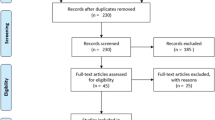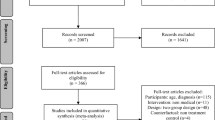Abstract
We evaluated how children with autism make linguistic adjustments when talking with someone else. We devised two novel measures to assess (a) overall conversational linkage and (b) utterance-by-utterance resonance within dialogue between an adult and matched participants with and without autism (n = 12 per group). Participants with autism were less able to establish ‘cognitive linkage’ with an interlocutor. As predicted, only among children with autism was there a positive correlation between the ability to link in with speaker’s meanings and ratings of emotional connectedness with the conversational partner. Participants with autism were not less likely to show a basic form of dialogic resonance across successive utterances (the ‘frame grab’), but more often elaborated their responses in an atypical manner.

Similar content being viewed by others
References
Adams, C., Green, J., Gilchrist, A., & Cox, A. (2002). Conversational behaviour of children with Asperger syndrome and conduct disorder. Journal of Child Psychology and Psychiatry, 43, 679–690.
American Psychiatric Association (1994). Diagnostic and statistical manual of mental disorders: Revised fourth edition (DSM-IV). Washington, DC: APA.
Baltaxe, C. A. M. (1977). Pragmatic deficits in the language of autistic adolescents. Journal of Pediatric Psychology, 2, 176–180.
Bock, J. K. (1986). Syntactic persistence in language production. Cognitive Psychology, 18, 355–387.
Branigan, H., Pickering, M., & Cleland, A. A. (2000). Syntactic co-ordination in dialogue. Cognition, 75(B), 813–825.
Bråten, S. (Ed.). (1998). Intersubjective communication and emotion in early ontogeny. Cambridge: University Press.
Capps, L., Kehres, J., & Sigman, M. (1998). Conversational abilities among children with autism and children with developmental delays. Autism, 2, 325–344.
Charman, T., Swettenham, J., Baron-Cohen, S., Cox, A., Baird, G., & Drew, A. (1997). Infants with autism: An investigation of empathy, pretend play, joint attention, and imitation. Developmental Psychology, 33, 781–789.
Cohen, J. (1960). A coefficient of agreement for nominal scales. Educational and Psychological Measurement, 20, 37–46.
Dobbinson, S., Perkins, M. R., & Boucher, J. (1998). Structural patterns in conversations with a woman who has autism. Journal of Communication Disorders, 31, 113–134.
Du Bois, J. W. (2001). Towards a dialogic syntax. Unpublished manuscript, Santa Barbara.
Du Bois, J. W. (2007). The stance triangle. In R. Englebretson (Ed.), Stancetaking in discourse: Subjectivity, evaluation, interaction (pp. 139–182). Amsterdam: Benjamins.
Du Bois, J. W. (2012). Towards a dialogic syntax. Cognitive Linguistics (in press).
Du Bois, J. W., Hobson, R. P., & Hobson, J. A. (2012). Dialogic resonance in autism. Cognitive Linguistics (in press).
Dunn, L. M., Dunn, L. M., & Whetton, C. (1982). British picture vocabulary scale. Windsor: NFER-Nelson.
Eales, M. J. (1993). Pragmatic impairments in adults with childhood diagnoses of autism or developmental receptive language disorder. Journal of Autism and Developmental Disorders, 23, 593–617.
García-Pérez, R. M., Hobson, R. P., & Lee, A. (2008). Narrative role-taking in autism. Journal of Autism and Developmental Disorders, 38, 156–168.
García-Pérez, R. M., Lee, A., & Hobson, R. P. (2007). On intersubjective engagement in autism: A controlled study of nonverbal aspects of conversation. Journal of Autism and Developmental Disorders, 37, 1310–1322.
Gentner, D. (1983). Structure-mapping: A theoretical framework for analogy. Cognitive Science, 7, 155–170.
Gentner, D., & Markman, A. (1997). Structure mapping in analogy and similarity. American Psychologist, 52, 45–56.
Grice, H. P. (1968). Utterer’s meaning, sentence-meaning, and word-meaning. Foundations of Language, 4, 225–242.
Happé, F. G. E. (1993). Communicative competence and theory of mind in autism: A test of relevance theory. Cognition, 48, 101–119.
Harris, Z. S. (1952). Discourse analysis. Language, 28, 1–30.
Hobson, J. A., Harris, R., García-Pérez, R., & Hobson, R. P. (2009b). Anticipatory concern: A study in autism. Developmental Science, 12, 249–263.
Hobson, J. A., & Hobson, R. P. (2007). Identification: The missing link between imitation and joint attention? Development and Psychopathology, 19, 411–431.
Hobson, R. P. (1993). Autism and the development of mind. Hillsdale: Erlbaum.
Hobson, R. P. (2007). Communicative depth: Soundings from developmental psychopathology. Infant Behavior and Development, 30, 267–277.
Hobson, R. P. (2012). Autism, literal language and concrete thinking: Some developmental considerations. Metaphor and Symbol, 27, 4–21.
Hobson, R. P., Chidambi, G., Lee, A., & Meyer, J. A. (2006). Foundations for self-awareness: An exploration through autism. Monographs of the Society for Research in Child Development, 284(71), 1–165.
Hobson, R. P., García-Pérez, R., & Lee, A. (2009a). Person-centred (deictic) expressions and autism. Journal of Autism and Developmental Disorders, 40, 403–415.
Hobson, R. P., & Hobson, J. A. (2008). Dissociable aspects of imitation: A study in autism. Journal of Experimental Child Psychology, 101, 170–185.
Hobson, R. P., & Lee, A. (1998). Hello and goodbye: A study of social engagement in autism. Journal of Autism and Developmental Disorders, 28, 117–127.
Hobson, R. P., & Lee, A. (1999). Imitation and identification in autism. Journal of Child Psychology and Psychiatry, 40, 649–659.
Hobson, R. P., Lee, A., & Hobson, J. A. (2007). Only connect? Communication, identification, and autism. Social Neuroscience, 2, 320–335.
Hobson, R. P., Lee, A., & Hobson, J. A. (2009c). Personal pronouns and communicative engagement in autism. Journal of Autism and Developmental Disorders, 40, 653–664.
Hobson, R. P., & Meyer, J. A. (2005). Foundations for self and other: A study in autism. Developmental Science, 8, 481–491.
Holyoak, K. J., & Thagard, P. (1995). Mental leaps: Analogy in creative thought. Cambridge, MA: MIT Press.
Hummel, J. E., & Holyoak, K. J. (1997). Distributed representations of structure: A theory of analogical access and mapping. Psychological Review, 104, 427–466.
Itkonen, E. (2008). The central role of normativity in language and linguistics. In J. Zlatev, T. P. Racine, C. Sinha, & E. Itkonen (Eds.), The shared mind: Perspectives on intersubjectivity (pp. 279–305). Amsterdam: Benjamins.
Jakobson, R. (1960). Closing statement: Linguistics and poetics. In T. A. Sebeok (Ed.), Style in language (pp. 350–377). Cambridge, MA: MIT Press.
Jakobson, R. (1966). Grammatical parallelism and its Russian facet. Language, 42, 398–429.
Jarrold, C., Boucher, J., & Russell, J. (1997). Language profiles in children with autism: Theoretical and methodological implications. Autism, 1, 57–76.
Kanner, L. (1943). Autistic disturbances of affective contact. Nervous Child, 2, 217–250.
Lee, A., & Hobson, R. P. (1998). On developing self-concepts: A controlled study of children and adolescents with autism. Journal of Child Psychology and Psychiatry, 39, 1131–1144.
Lee, A., Hobson, R. P., & Chiat, S. (1994). I, you, me and autism: An experimental study. Journal of Autism and Developmental Disorders, 24, 155–176.
Medin, D. L., Goldstone, R. L., & Gentner, D. (1993). Respects for similarity. Psychological Review, 100, 254–278.
Meyer, J. A., & Hobson, R. P. (2004). Orientation in relation to self and other: The case of autism. Interaction Studies, 5, 221–244.
Ochs, E., & Solomon, O. (2005). Practical logic and autism. In C. Casey & R. B. Edgerton (Eds.), A companion to psychological anthropology (pp. 140–167). London: Blackwell.
Schopler, E., Reichler, R., & Renner, B. R. (1986). The childhood autism scale (CARS) for diagnostic screening and classification of autism.. New York: Irvington.
Shrout, P. E., & Fleiss, J. L. (1979). Intraclass correlation: Uses in assessing rater reliability. Psychological Bulletin, 86, 420–428.
Sigman, M. D., Kasari, C., Kwon, J.-H., & Yirmiya, N. (1992). Responses to the negative emotions of others by autistic, mentally retarded, and normal children. Child Development, 63, 796–807.
Sorce, J. F., Emde, R. N., Campos, J., & Klinnert, M. D. (1985). Maternal emotional signaling: Its effect on the visual cliff behavior of 1-year-olds. Developmental Psychology, 21, 195–200.
Stern, D. N. (1985). The interpersonal world of the infant. New York: Basic Books.
Tager-Flusberg, H., & Anderson, M. (1991). The development of contingent discourse ability in autistic children. Journal of Child Psychology and Psychiatry, 32, 1123–1134.
Trevarthen, C. (1979). Communication and cooperation in early infancy: A description of primary intersubjectivity. In M. Bullowa (Ed.), Before speech (pp. 321–347). Cambridge: Cambridge University Press.
Trevarthen, C., & Hubley, P. (1978). Secondary intersubjectivity: Confidence, confiding and acts of meaning in the first year. In A. Lock (Ed.), Action, gesture and symbol: The emergence of language (pp. 183–229). London: Academic Press.
Vygotsky, L. S. (1962). Thought and language (translated by E. Hanfmann & G. Vakar). Cambridge, Mass: M.I.T. Press.
Wimpory, D. C., Hobson, R. P., Williams, J. M. G., & Nash, S. (2000). Are infants with autism socially engaged? A controlled study of recent retrospective parental reports. Journal of Autism and Developmental Disorders, 30, 525–536.
Zahavi, D. (2001). Beyond empathy: Phenomenological approaches to intersubjectivity. Journal of Consciousness Studies, 8, 151–167.
Zlatev, J., Racine, T. P., Sinha, C., & Itkonen, E. (2008). Intersubjectivity. What makes us human? In J. Zlatev, T. P. Racine, C. Sinha, & E. Itkonen (Eds.), The shared mind: Perspectives on intersubjectivity (pp. 1–14). Amsterdam: Benjamins.
Acknowledgments
We thank the pupils, parents and staff of the UK schools where the interviews were conducted, and our colleagues Tony Lee and Kira Griffitt. We are greatly indebted to the Baily Thomas Charitable Fund and the NHS R&D Levy. Portions of this work were completed when the first author was a Fellow and the second author a Visiting Scholar at the Center for Advanced Study in the Behavioural Sciences at Stanford University. The work reported here includes data from the PhD dissertation of the third author. The last author is grateful for support from the University of California, Santa Barbara Academic Senate.
Author information
Authors and Affiliations
Corresponding author
Rights and permissions
About this article
Cite this article
Hobson, R.P., Hobson, J.A., García-Pérez, R. et al. Dialogic Linkage and Resonance in Autism. J Autism Dev Disord 42, 2718–2728 (2012). https://doi.org/10.1007/s10803-012-1528-6
Published:
Issue Date:
DOI: https://doi.org/10.1007/s10803-012-1528-6




